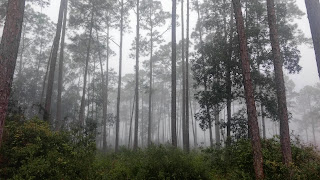Alligators, alligators and more alligators... large, medium, small... alone or bunched up in a group... they are everywhere we look. They are the American Alligator and it has estimated that 12,000 of them live in the Okefenokee swamp. But no worries, there hasn't been an accident since 1936.
Fun fact: a crocodile can be distinguished from an alligator by its snout. Crocodiles have more elongated snouts, while alligators have more of a blunt snout with a bump. Also alligators are less aggressive than crocodiles.
We took an hour and a half boat tour with a guide in the morning. Our guide was very knowledgeable and he entertained us with all kinds of facts about the flora and fauna of the Okefenokee swamps.
The first stretch of the trip took us to Billy's lake, an open area of the swamps. The water was so still that it looked like black oil. The reflections made perfect mirror images.
The trees in this area were scarce due to several past fires, fueled by the peat moss present in this swamp during drought periods. On 2007 a fire burned the entire park. Then there was another one in 2011. The forest is still recovering and it will take several years. But I guess it's just another phase in the swamp, as a naturally occurring event.
We drove up the lake and then we turned into a side tributary. The river got smaller and we saw more bald and pond cypresses and yellow water lilies, not yet in bloom.
Our guide showed us an aquatic plant with small yellow flowers called Bladderwort which is carnivorous. In its root system the plant has several bladders with holes. A small nematode or a small insect larva can enter but cannot leave. The trapped insect then decomposes, releasing nitrogen needed by the plant.
 |
| Bladderwort flowers |
 |
| The bubbles are in fact bladders |
We wanted to go all the way to Minnie's lake. It was a paddle of 3.8 miles one way. It was worth it!
 |
| Mama turtle with baby |
 |
| Cormorants |
 |
| Large gator |
By the shelter, we were lucky to see a small raccoon fishing in the marsh. It looked so nervous and in a hurry, being a raccoon in water infested with gators. It was not distracted by our presence in its search for food.
Not yet happy with our adventure, we wanted to explore more of the swamp. Our guide directed us to an area outside the park called the River Sill. The primary purposes of the Suwannee River Sill were to facilitate wildfire control by creating impounded conditions during periods of drought, and to arrest the spread of wildfires across the landscape by prolonging inundation. Unfortunately the sill did not work as expected. Moreover, at a certain point of its history, a breach formed. So now it has lost completely its usefulness, but it makes for a nice hike for fishermen and tourists.
 |
| White Ibis |
We may have inadvertently saved an ibis while walking by! Right after Bill stopped filming, the gator went back into the water with a big splash, feeling frustrated by our presence.
 |
| Find the intruder |
 |
| how many are there in this picture? |









































